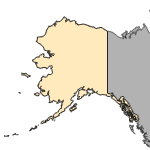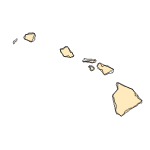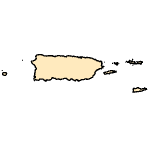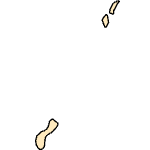Geophagus sp.
(earth eaters)
Fishes
Exotic |
|
Common name: earth eaters
Taxonomy: available through
www.itis.gov
Identification: Kullander and Nijssen (1989) revised the genus Geophagus, including a redescription of G. surinamensis. A few distinguishing characteristics and a figure were also given by Page and Burr (1991). López-Fernández and Taphorn (2004) provided a key to Venezualen species of Geophagus and presented distinguishing characters for the G. surinamensis species complex.
Size: 30 cm.
Native Range: Tropical America. Widely distributed throughout the Amazon, Orinoco, Suriname, Essiquibo, and other major river basins in Panama and northern South America (Kullander and Nijssen 1989; Kullander 2003).



|

Alaska |

Hawaii |

Puerto Rico &
Virgin Islands |

Guam Saipan |
Hydrologic Unit Codes (HUCs) Explained
Interactive maps: Point Distribution Maps
Nonindigenous Occurrences:
A single fish (originally identified as G. brasiliensis) was collected from a canal near a fish farm west of Lantana, Palm Beach County, Florida (Courtenay et al. 1974). Two fish (originally identified as G. surinamensis) were taken from Snapper Creek canal north of its junction with Tamiami Canal in the Miami area of Miami-Dade County, in April 1981. Loftus and Kushlan (1987) did not collect this species at those locations during electrofishing in 1980. A small reproducing population was observed and fry and adults were collected in the same 1-km reach of Snapper Creek during visits in May, and from June to July 1982 (Metzger and Shafland 1984). Additional specimens have been taken from Snapper Creek and one of its tributaries in the late 1980s and early 1990s and from Tamiami Canal in the 2000s (Shafland 1996; Shafland et al. 2008).
Table 1. States with nonindigenous occurrences, the earliest and latest observations in each state, and the tally and names of HUCs with observations†. Names and dates are hyperlinked to their relevant specimen records. The list of references for all nonindigenous occurrences of Geophagus sp. are found here.
Table last updated 12/19/2025
† Populations may not be currently present.
Means of Introduction: Probable escape or release from fish farm, or aquarium release (Metzger and Shafland 1984).
Status: Originally considered established in Miami-Dade County canals (Shafland 1996); Shafland et al. (2008) reported that no specimens have been collected or reported since 2004 (although a single Geophagus sp. was collected in 2009; museum specimen), indicating either severe population decline or extirpation.
Impact of Introduction: The impacts of this species are currently unknown, as no studies have been done to determine how it has affected ecosystems in the invaded range. The absence of data does not equate to lack of effects. It does, however, mean that research is required to evaluate effects before conclusions can be made.
References: (click for full references)
Courtenay, W.R., Jr., H.F. Sahlman, W.W. Miley II, and D.J. Herrema. 1974. Exotic fishes in fresh and brackish waters of Florida. Biological Conservation 6(4):292-302.
Kullander, S.O. 2003. Family Cichlidae (Cichlids). Pages 605-654 in Reis, R.E., S.O. Kullander, and C.J. Ferraris, Jr, eds. Check list of the freshwater fishes of South and Central America. EDIPUCRS. Porto Alegre, Brazil.
Kullander, S.O., and H. Nijssen. 1989. The cichlids of Surinam, Teleostei: Labroidei. E.J. Brill, New York, NY.
Loftus, W.F., and J.A. Kushlan. 1987. Freshwater fishes of southern Florida. Bulletin of the Florida State Museum of Biological Science 31(4):147-344.
López-Fernández, H., and D.C. Taphorn. 2004. Geophagus abalios, G. dicrozoster, and G. winemilleri (Perciformes: Cichlidae), three new species from Venezuela. Zootaxa 439:1-27.
Metzger, R.J., and P.L. Shafland. 1984. Possible establishment of Geophagus surinamensis (Cichlidae) in Florida. Florida Scientist 47(3):201-203.
Page, L.M., and B.M. Burr. 1991. A field guide to freshwater fishes of North America north of Mexico. The Peterson Field Guide Series, volume 42. Houghton Mifflin Company, Boston, MA.
Shafland, P.L. 1996. Exotic fishes of Florida – 1994. Reviews in Fisheries Science 4(2):101-122.
Shafland, P.L., K.B. Gestring, and M.S. Stanford. 2008. Florida's exotic freshwater fishes - 2007. Florida Scientist 71(3):220-245.
Other Resources:
FishBase Summary
Author:
Leo Nico, and Matt Neilson
Revision Date: 5/9/2019
Peer Review Date: 7/22/2013
Citation Information:
Leo Nico, and Matt Neilson, 2025, Geophagus sp. Heckel, 1840: U.S. Geological Survey, Nonindigenous Aquatic Species Database, Gainesville, FL, https://nas.er.usgs.gov/queries/FactSheet.aspx?speciesID=455, Revision Date: 5/9/2019, Peer Review Date: 7/22/2013, Access Date: 12/19/2025
This information is preliminary or provisional and is subject to revision. It is being provided to meet the need for timely best science. The information has not received final approval by the U.S. Geological Survey (USGS) and is provided on the condition that neither the USGS nor the U.S. Government shall be held liable for any damages resulting from the authorized or unauthorized use of the information.